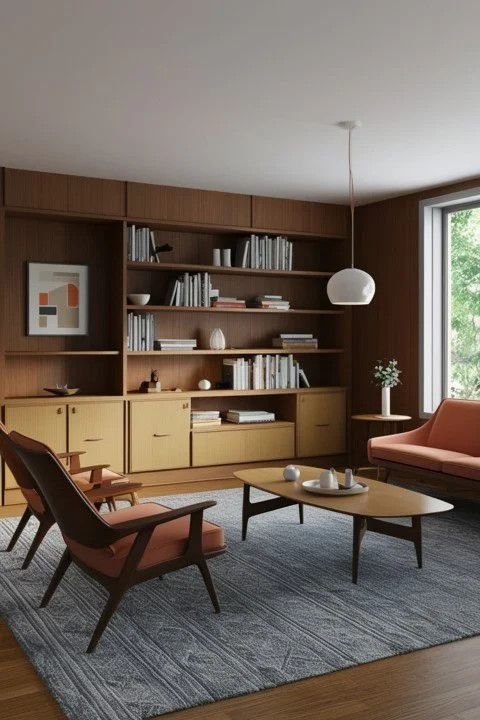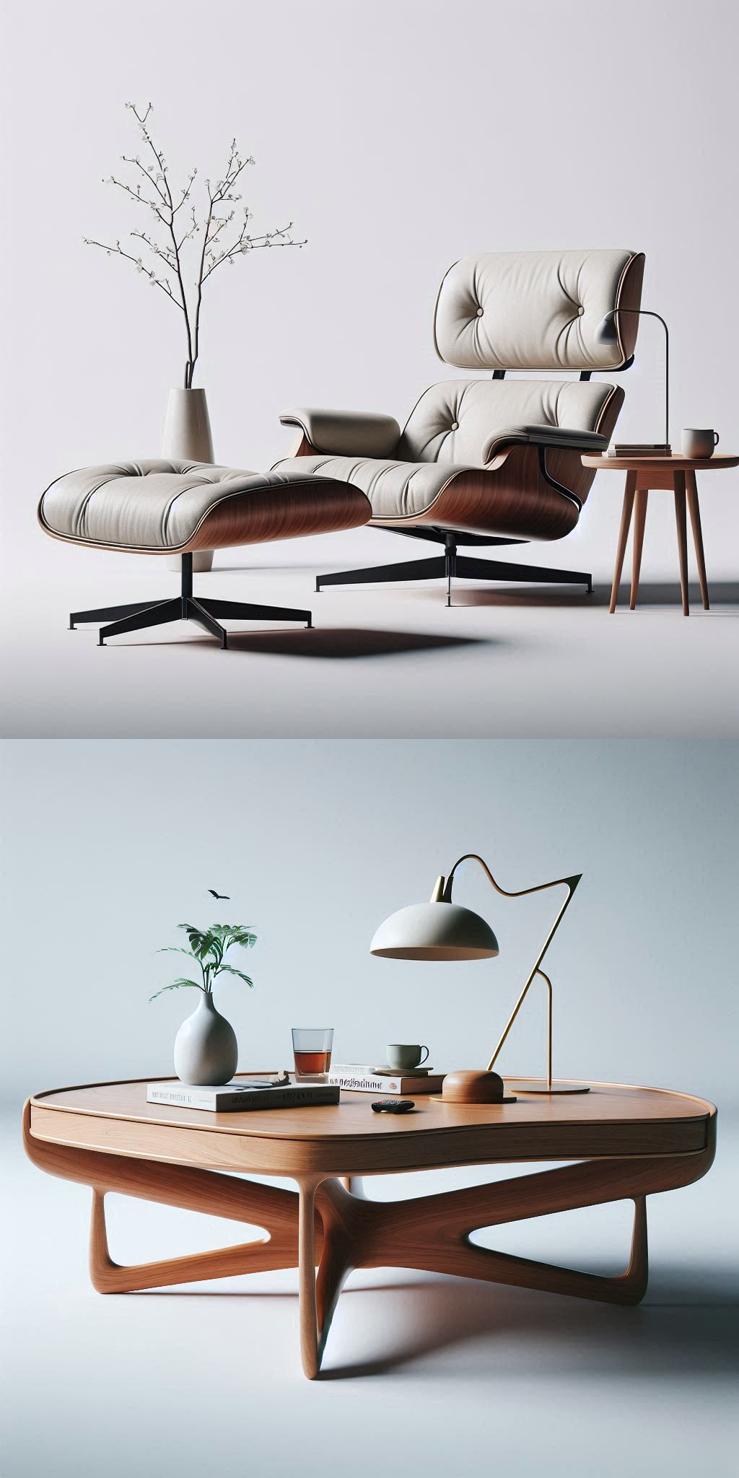Midcentury modern style is a timeless design movement that emerged in the mid-20th century, particularly from the 1940s to the 1960s.
Known for its clean lines, functionality, and integration with nature, it continues to influence interior and architectural design today by emphasizing simplicity and innovation, which is just as important now as it was then.
The Origins of Midcentury Modern
The roots of the style go back to the post-World War II era when designers sought to create practical yet beautiful spaces, Influenced by the Bauhaus movement and Scandinavian design.
This style prioritizes efficiency, durability, and an aesthetic that feels timeless.
A hallmark of midcentury modern design is the emphasis on open spaces and natural light.
To blur the lines between indoors and outdoors, large windows are often used to create a seamless connection to nature. These are typically framed in clean, minimalistic ways that complement the simplicity of the overall space.
Key Characteristics of Midcentury Modern Style
Clean Lines and Simple Forms
Furniture often has smooth surfaces, geometric shapes, and a lack of ornate detailing.
This simplicity is paired with innovative materials like molded plywood, fiberglass, and steel, which allow for sleek and functional designs.
Functionality Over Ornamentation
Every element in a MCM room is carefully considered for its purpose and contribution to the overall design.
Built-in shelves, multi-functional furniture, and minimal decor reflect this emphasis on functionality.
Integration with Nature
Designers use organic materials like wood, stone, and leather alongside earthy tones to enhance the connection to nature.
Alexandra Folster
Indoor plants and access to outdoor views are also common features that reinforce the idea of living in harmony with the environment.
Midcentury Modern Furniture
Iconic Furniture Designs
Iconic pieces like the Eames Lounge Chair, Noguchi Coffee Table, and the Tulip Chair exemplify the movement’s focus on innovative materials and functional design.
These are stylish and designed with ergonomics in mind, which ensure comfort without sacrificing aesthetic appeal.
These pieces often have tapered legs, low profiles, and a combination of natural and man-made materials.
Material and Color Palette
Midcentury modern design balances natural materials like teak, walnut, and oak with bold pops of color. Common hues include mustard yellow, burnt orange, olive green, and turquoise.
These colors are often set against neutral backgrounds like white or gray to create visual contrast.
Midcentury Modern Architecture
Open Floor Plans
Open floor plans create a sense of spaciousness and flow. Walls are minimized to allow for an unbroken visual connection between living areas, which enhances the feeling of openness.
These layouts are designed to accommodate modern lifestyles, with spaces that serve multiple functions.
For example, a living room may seamlessly transition into a dining area to encourage social interaction and flexibility.
Connection to the Outdoors
Architects of this era emphasized integrating the home with its natural surroundings.
Large sliding glass doors and expansive windows flood interiors with natural light and provide easy access to outdoor patios spaces or gardens.
Remember, this design philosophy underscores the importance of blending indoor and outdoor spaces.
The Style in Modern Times
Why It Endures
The timeless appeal of midcentury modern design lies in its versatility and focus on functionality.
It adapts easily to contemporary interiors and offers a balance of style and practicality.
Zhengdong Hu
Its emphasis on natural materials and simplicity resonates with today’s preference for a sustainable and minimalistic lifestyle.
Does the Style Need to Be Revived?
Many homeowners today are reviving midcentury modern style by incorporating vintage furniture, updating original architectural features, or using reproductions.
Max Vakhtbovycn
This approach allows for a blend of classic and contemporary pieces to create spaces that feel both fresh and a little nostalgic.
Tips to Incorporate Midcentury Modern Style
1. Invest in iconic furniture: Choose classic pieces from famous designers. Visit antique shops, online marketplaces, and estate sales.
2. Focus on functionality: Choose furniture that serves more than one purpose and maintains a clean look. For example, a dining buffet that could be a TV console. Or a small, walnut cabinet that could be a mini bar or office cabinet.
3. Use natural light: Maximize light with minimal window coverings and strategic furniture placement.
4. Layer textures: Combine materials like wood, glass, and fabric for depth.
5. Keep it uncluttered: Maintain a minimalist approach to decor for an open and simple feel.
Key Elements of Midcentury Modern Design
1. Clean lines: Furniture and decor with minimalistic, geometric shapes.
2. Natural materials: Use of wood, leather, and stone for warmth and texture.
3. Neutral backdrops: Walls in shades of white, beige, or gray to emphasize simplicity.
4. Bold accents: Pops of color in furnishings or artwork for visual interest.
5. Indoor-outdoor flow: Large windows and open layouts to connect with nature.
Ways to Bring Midcentury Modern to Your Space
The style is not confined to architecture and furniture — it can be adapted to any space with thoughtful design choices. No matter if you live in a suburban home or a city apartment, elements of this style can elevate your interior.
Focus on quality over quantity and choose pieces that reflect the aesthetic of simplicity and innovation.
A combination of vintage finds and modern reproductions can create a harmonious blend of old and new.
The MCM design philosophy aligns perfectly with small rooms and tricky layouts.
Keeping your design choices simple and intentional is important in rooms with small floor plans because using every inch of space wisely will make your space feel fully functional, with a well-thought-out flow.
Midcentury Modern as a Lifestyle
Beyond its visual appeal, midcentury modern design reflects a way of living that values intentionality, simplicity, and a connection to the environment.
Its enduring popularity speaks to its ability to adapt to people’s needs while maintaining a very distinctive character.
Integrating MCM elements into your home allows you to create a space that’s functional and timeless.
Large windows that flood your home with light, comfortable yet simple furniture, and a well-planned layout all contribute to a classic and timeless design.
If you are starting from scratch or adding touches to an existing design, this style offers endless possibilities for creating a space that feels classic and contemporary.
Now it’s your turn.
Do you love MCM style? How do you use your favorite aspects of this timeless design style in your home? Leave me a comment below.
Read Next:
The Art of Layering Luxe Decor for a Rich and Inviting Home
Give your home a high-end, designer feel with effortless layering. Deep wall colors, sculptural decor, and the right lighting create warmth and sophistication, while books, mirrors, and textured accents add depth. Elevate any space—big or small—with these simple, stylish ideas.
Michael is Principal designer and blogger at Michael Helwig Interiors in beautiful Buffalo, New York. Since 2011, he’s a space planning expert, offering online interior e-design services for folks living in small homes, or for those with awkward and tricky layouts. He’s a frequent expert contributor to many National media publications and news outlets on topics related to decorating, interior design, diy projects, and more. Michael happily shares his experience to help folks avoid expensive mistakes and decorating disappointments. You can follow him on Pinterest, Instagram and Facebook @interiorsmh.
























